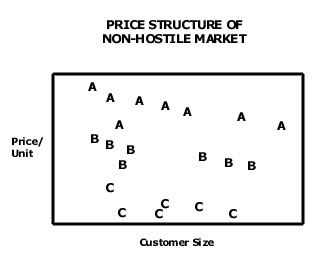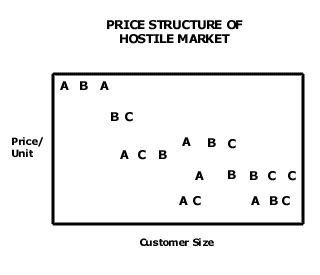Countering Falling Prices with StrategyStreet
Our Experience in Pricing: Articles on Pricing
| The New Pricing Structure
by Donald Potter The onset of hostility is a shock for many companies not only because they lose the ability to control prices but because their whole approach to pricing is suddenly no longer applicable. This occurs because the structures of industry prices are fundamentally different in hostile and non-hostile markets. In Non-Hostile Markets, Price Differs by "Companies normally charge customers the same price." In a non-hostile market, the price that any supplier charges for a unit of product will be pretty much the same for any customer, regardless of the customer's purchase volume. In other words, any individual supplier's prices to its entire customer group will fall within a narrow range – typically 3-6%. At the same time, competing suppliers will price very differently from one another. Usually the market leader charges the highest price, with less dominant competitors pricing lower. For any given customer, the price charged by a market leader and a low-priced supplier can differ by 15-30% on products with comparable benefits. The chart below shows how three competing suppliers – A (the market leader), B, and C might price their products for various customers in a non-hostile market: Price Structure of Non-Hostile Market When a market is not hostile, suppliers are not really competing on price, so customers have little leverage with their suppliers. A customer who wants to lower his purchase price has only one real option: switch from supplier A to B or C. In Hostile Markets, Price Differs by "In hostility customers get individual pricing." The structure of a hostile market is very different. First, all prices have fallen to lower levels. Second, price differences among competitors for any given product have narrowed to only 2-3%. Third, the price that any given supplier charges its customers has widened, and may vary 20-30% from small to large customers . The chart below shows how competing suppliers A, B, and C might price in a hostile market where "C" shaves prices by 2-3% to hold its volume. Price Structure of Hostile Market In a hostile market, suppliers scramble for volume, and customers have real leverage. Prices are "customized" for each customer. Large customers are usually best positioned to negotiate the most favorable prices (including terms and discounts.) Any one supplier will have nearly as many real prices as it has customers. But, inside the customer relationship, all suppliers, except price shavers, charge the same price. Square Pegs, Round Holes "The old way doesn't fit the new reality." For suppliers, surviving market hostility requires keeping the largest customers satisfied, because their volume is essential. In a hostile market, the goal is not selling products Unfortunately, a supplier's perspective and attitudes toward pricing, and its internal structure and systems, all typically focus on the product. R and D works to develop new products or product lines. Sales efforts tout a product's advantages. The company may be organized into product divisions, with managers' careers rising or falling with their product lines. Most companies track cost by product and manage price by product. The approach to pricing that worked well before hostility began can become a problem when the market turns hostile. Like a square peg for a round hole, the old way of doing business doesn't fit the new reality. Customers almost always buy more than one product, and as market hostility increases their negotiating leverage, they insist on price discounts for their entire product package. How should this discount be reflected in the revenues for various products? Furthermore, customers may ask for additional services such as marketing or technical support, which will raise SG&A. Which product(s) should bear the burden of the SG&A allocation? New systems may be needed to reflect the new reality of customer preeminence and to take into account the complexity of managing costs by customer and maintaining a range of prices. But systems changes may not be enough. Who within the organization is responsible for ensuring that the customer relationship is secure? Whose career rises and falls with the customer, not the product? How can the organization accept that a product is only a contribution to the fixed cost and overhead of keeping a customer? Closing Thought In hostility, revenue management moves its focus from products to customers. (Note: This Perspective was written in the context of the economy in 1994. While some of the companies may have changed their policies or indeed no longer exist, the patterns they exhibit still hold today.) |


